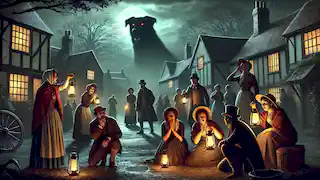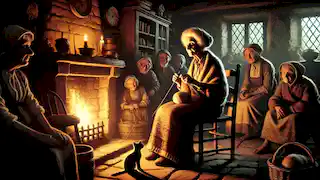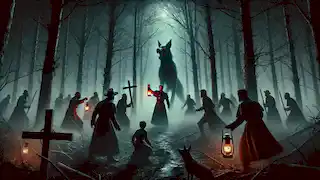Introduction
The legend of the Black Dog has been whispered across the moors, down the cobbled streets, and through the ancient woodlands of England for centuries. With origins deeply embedded in English folklore, the tale has transcended time, shifting and evolving through generations. Stories about spectral black dogs, often associated with death and ill omens, have cropped up in various regions of the country, each with its own unique spin. The following recounts the tale of one such Black Dog—a story of mystery, fear, and an enduring darkness that haunts the minds of those who hear it.
The Omen
It was a crisp autumn evening in the small village of Blytheburn, nestled in the heart of Suffolk. The wind howled through the ancient oak trees that lined the village square, carrying with it the scent of damp earth and rotting leaves. Blytheburn had always been a quiet place, the kind of village where everyone knew each other's name and where time seemed to move a little slower. But on this particular evening, a heavy sense of unease settled over the village like a shroud.
Old Martha, who ran the local apothecary, had seen the creature first. She had been closing her shop for the night when, out of the corner of her eye, she spotted something moving in the shadows. At first, she thought it was one of the many stray dogs that roamed the countryside, but as she looked closer, her heart seized in her chest.
Standing at the edge of the village green, staring straight at her, was a massive black dog. Its fur was sleek, as dark as midnight, and its eyes gleamed a fiery red. It stood perfectly still, unnervingly so, as if waiting for something.
Martha had heard the stories, of course. Everyone in Blytheburn had. The Black Dog was an omen, a harbinger of death. It appeared without warning, always just out of reach, watching and waiting. And when it vanished, death soon followed.
Without thinking, Martha slammed the shutters closed and bolted the door. Her hands shook as she muttered a prayer under her breath, hoping against hope that the creature would disappear as quickly as it had appeared.
The next morning, the village was buzzing with news of Old Reginald, the town’s blacksmith, who had been found dead in his home. The cause of death was unclear, but those who had seen him said his face was twisted in a look of pure terror.
The Black Dog had come to Blytheburn.

A Village in Fear
News of Reginald’s death spread quickly, and the village of Blytheburn was soon gripped by fear. It wasn’t long before others began claiming they, too, had seen the Black Dog lurking in the shadows. Some swore they had heard its low, menacing growl late at night. Others said they had glimpsed its glowing red eyes watching them from the edge of the forest.
But no one could say where the creature came from or why it had chosen Blytheburn. The villagers, though simple folk, were deeply superstitious. To them, the appearance of the Black Dog could only mean one thing: more deaths would follow.
Father Edward, the village priest, tried to calm the growing panic. He spoke of faith and trust in the Lord, but even he could not shake the feeling of dread that had settled over Blytheburn. The church bells rang more frequently, calling the villagers to prayer in an effort to stave off the darkness that seemed to be creeping ever closer.
The village elders gathered in the pub one evening to discuss what could be done. Their faces were drawn and pale, and they spoke in hushed tones, as if speaking too loudly might summon the creature itself.
“We can’t just wait here for it to take more of us,” said John Hargrove, the local miller. “We have to do something.”
“What would you have us do?” Martha chimed in. “We don’t even know what it is, let alone how to stop it.”
The discussion went round in circles, with no clear answers. Fear had taken root in the hearts of the villagers, and no amount of talk could dispel it.
As the days passed, more villagers reported sightings of the Black Dog. It was always the same—large, black, and silent, its eyes glowing with an otherworldly light. No one dared to approach it, and those who caught sight of it were plagued by nightmares for days afterward.
It wasn’t long before the deaths began to mount. Old Mrs. Craggs, who lived alone at the edge of the village, was found dead in her bed one morning, her eyes wide open in a look of sheer horror. Then young Tom, the butcher’s apprentice, collapsed in the street without warning, his heart stopping before anyone could help him.
The Black Dog was claiming its victims, one by one.

The Legend Unveiled
Desperate for answers, the villagers turned to the oldest person they knew: Agnes Ashford, a woman so ancient and frail that she seemed to belong to another time entirely. Agnes had lived in Blytheburn her entire life, and she had heard more stories and legends than anyone else in the village.
When Father Edward and a few of the elders visited her cottage, they found her sitting by the fire, knitting quietly. Her gnarled hands moved deftly over the needles, despite her age.
“We need your help, Agnes,” Father Edward began. “The Black Dog has returned to Blytheburn, and we don’t know how to stop it.”
Agnes said nothing for a moment, her eyes fixed on the fire. Then, slowly, she nodded.
“I know the creature you speak of,” she said, her voice a raspy whisper. “It is not of this world, but it has been here before. Long ago.”
The villagers leaned in, hanging on her every word.
“The Black Dog is a spirit,” Agnes continued. “It appears when great tragedy is about to strike. But it is not the cause of death—it is merely a messenger, a warning.”
The villagers exchanged nervous glances.
“But why has it returned now?” John Hargrove asked.
Agnes shook her head. “I do not know. But I do know this: once the Black Dog has come, it will not leave until its purpose has been fulfilled.”
“What purpose?” Father Edward asked.
“To warn us of what is to come. Death is not the end, but a beginning. The Black Dog comes to show us the way, but it does not force our hand.”
The villagers were silent, absorbing her words. It was clear that Agnes knew more than she was saying, but she would not—could not—reveal everything.
As they left her cottage, the weight of the Black Dog’s presence seemed heavier than ever. The villagers realized that they were not simply dealing with an animal or even a ghost, but something far older and far more dangerous.

The Final Confrontation
In the weeks that followed, the sightings of the Black Dog increased, as did the number of sudden and unexplained deaths. The once-peaceful village of Blytheburn was now a place of mourning and fear. People stayed indoors after dark, locking their doors and praying for morning to come.
But the Black Dog did not care for doors or locks. It moved through the night with silent purpose, always watching, always waiting.
One evening, Father Edward gathered the remaining villagers in the church for a final prayer. The air inside was thick with fear, and the flickering candlelight cast long, eerie shadows on the walls.
“We must face this creature,” Father Edward said, his voice trembling but resolute. “If we do nothing, it will continue to haunt us. We must confront it and put an end to this madness.”
A small group of men volunteered to join Father Edward in the search for the Black Dog. Armed with lanterns and whatever weapons they could find, they set out into the night, their footsteps echoing on the cobblestone streets.
For hours, they searched the village and its outskirts, but there was no sign of the creature. The moon hung low in the sky, casting a ghostly light over the landscape, and the wind howled through the trees.
Just as they were about to give up, they heard it—a low, rumbling growl, coming from the edge of the forest. The men froze, their hearts pounding in their chests.
There, standing just beyond the tree line, was the Black Dog. Its eyes glowed with a malevolent light, and its fur seemed to shimmer in the moonlight. It was larger than any dog they had ever seen, and there was something about it—something otherworldly—that sent a chill down their spines.
Father Edward stepped forward, his hand clutching a crucifix.
“In the name of God,” he began, his voice shaking, “I command you to leave this place!”
The Black Dog didn’t move. It simply stared at him, its red eyes burning with an ancient, unknowable power.
Suddenly, the wind picked up, swirling around the men like a cyclone. The lanterns flickered and went out, plunging them into darkness. The growling grew louder, more menacing, as if the very earth itself was rumbling beneath their feet.
And then, just as quickly as it had started, the wind died down. The men opened their eyes to find the Black Dog gone, vanished into the night.
The Aftermath
The village of Blytheburn never truly recovered from the events of that autumn. Though the Black Dog was never seen again, the
fear it had instilled lingered for years to come. Many of the villagers moved away, unable to bear the memories of those dark days.
Those who remained spoke of the Black Dog in hushed tones, passing the story down to their children and grandchildren. Some believed that the creature was a demon, sent to claim the souls of the damned. Others thought it was a guardian, protecting the village from an even greater evil.
But no one could say for certain what the Black Dog truly was or why it had come to Blytheburn.
In time, the legend faded into folklore, a tale to be told around the fire on cold winter nights. But even today, some say that on a quiet, moonlit night, if you listen closely, you can still hear the distant growl of the Black Dog, lurking in the shadows, waiting for its next victim.




















